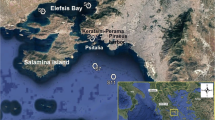Abstract
Trace metal concentrations in phytoplankton were determined in seven locations (Stations I–VII) of the Kuwait Coast, known for significant industrial and recreational activities. Trace metal concentrations in phytoplankton (20–200 μm size) occurred in the sequence of Zn>Pb>Cu>Ni at Stations I–III and VII, and Zn>Cu>Ni>Pb at Stations IV–VI. Station III showed higher concentrations of all the analyzed metals than at other stations. Toxicity tests to phytoplankton revealed a significant decrease in the rate of oxygen with increasing concentrations of trace metals. Further, such comparisons to station wise observations between the rate of oxygen evolution and trace metal levels revealed the nature of trace metal pollution in each station off the Kuwait coast.
Similar content being viewed by others
References
Ahner, B.A. and Morel, F.M.M. (1995). Phytochelatin production in marine algae-Induction by various metals. Limnology Oceanography 20, 658–65.
Anderlini, V.C., Mohammed, O.S. and Zarba, M.A. (1980). Distribution of trace elements in marine sediments of Kuwait, Final Report, KISR. 171 pp.
Bu-Olayan, A.H., Subrahmanyam, M.N.V., Al-Sarawi, M. and Thomas B.V. (1998). Effects of the gulf war oil spill in relation to trace metals in water, particulate matter and PAHs from the Kuwait coast. Environmental International 24, 789–97.
Dassenakis, M.I., Kloukiniotou, M.A. and Pavlidou, A.S. (1996). The influence of long existing pollution on trace metal levels in a small tidal mediterranean bay. Marine Pollution Bulletin 32, 275–82.
Edding, M. and Tala, F. (1996). Copper transfer and influence on a marine food chain. Bulletin of Environmental Contamination and Toxicology 57, 617–24.
Guillard, R.R.L. and Ryther, J.H. (1962). Studies on marine planktonic diatoms. I. Cyclotella nana Hustedt and Detonula confervacea (Cleve) Canadian Journal of Microbiology 8, 229–39.
Kusk, K.O. and Nyholm, N. (1991). Evaluation of a phytoplankton toxicity test for water pollution assessment and control. Archives of Environment Contamination and Toxicology 20, 375–9.
Lee, J.G. and Morel, F.M.M. (1995). Replacement of zinc by cadmium in marine phytoplankton. Marine Ecology Program Services 127, 305–9.
Literthy, P. and Salem, A. (1983). Effects of pollutants on water quality; fish kills, KISRrEES Report. 91 pp.
Shuaiba Area Authority. (1983). Pollution in the Marine Environment of Kuwait, 152 pp.
Sunda, W.G. and Huntsman, S.A. (1995). Regulation of copper concentration in the oceanic nutricline by phytoplankton uptake and regeneration cycles. Limnology and Oceanography 40, 132–7.
Turbak, S.C., Olson, S.B. and McFeters, G.A. (1986). Comparison of algal assay systems for detecting waterborne herbicides and metals. Water Research 20, 91–6.
Versteeg, D.J. (1990). Comparison of short and long term toxicity test results for the green alga, Selenestrum capricornutum. In W. Wang, J.W. Gorsuch, W.R. Lower (eds) Plants for Toxicity Assessment, ASTM STP 1091, pp. 40–8. Philadelphia, PA: American Society for Testing and Materials.
Author information
Authors and Affiliations
Rights and permissions
About this article
Cite this article
Bu-Olayan, A.H., Al-Hassan, R. & Thomas, B.V. Trace Metal Toxicity to Phytoplankton of Kuwait Coastal Waters. Ecotoxicology 10, 185–189 (2001). https://doi.org/10.1023/A:1016602329047
Issue Date:
DOI: https://doi.org/10.1023/A:1016602329047




